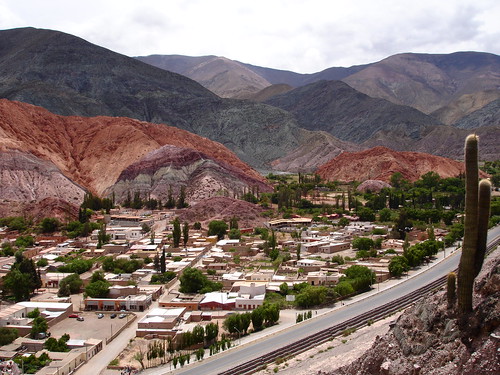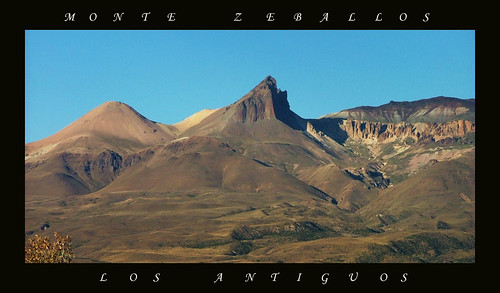
From Salta to Santa Cruz, drain the Andes Mountains and its foothills many winding roads that border the «high» beauty: the Quebrada de las Conchas Salta, Route 7 to the Christ Redeemer in Mendoza, the water crossing to Chile Black in San Juan, the route to the viewpoint of Cochuna in Tucuman and Camino of Monte Zeballos in Santa Cruz.
From the height, the edge of a cornice road, it captures the true dimension of the vastness of a landscape. The notion of space is lost as it enlarges the visual horizon, and getting it back soon when more than 1000 meters below is a small black dot moving on four wheels in slow motion through the route.
In a country like Argentina, sailed across the Andes, there are many paths where the previous scene is repeated, that they could write a travel guide with thick mountain trails. Then an almost arbitrary «high road» among many others, elected by region from the northwest to Cuyo and Patagonia.
The way Iruya:
On a trip to Iruya, like many other mountain villages in Salta, the way to there destination is worth the same. For starters, you go through all the Quebrada de Humahuaca in Jujuy. Leaving the famous broken pavement ends and gravel begins a very good state, first by the National Route 9 and then the provincial 133. A total of 70 kilometers, which can also be made collectively by a line connecting daily with Iruya Humahuaca.

The road climbs up to 4 thousand meters in the Abra del Condor, just the border between Salta and Jujuy. Then the road begins to descend in a zigzag pattern, while turning the bright colors of the hills and behind the window are little path that trace diagonal lines on the mountain. Far rectangular and circular stone walls proliferate, and appear herds of llamas, goats and sheep with their shepherd behind. There are also groups of two or three houses with a church, or homes that are directly travelers, all of adobe.
Calchaquies Valley:
Starting from Salta city along National Route 68 is reached the Quebrada de las Conchas, a panoramic road that leads to the town of Cafayate by Calchaquies Valley. A total of 66 kilometers between sedimentary mountains all imaginable shades of red that reflect the successive surfaces of the planet, accumulated on top of each other is between 65 and 75 million years.
The journey begins with the Lerma Valley, with its green plantations snuff, up to a village that became ghost when they closed the train. Just outside the village of Germany there is a sign that says «Quebrada de Cafayate. But the official maps say «Quebrada de las Conchas», and everyone knows it as such. The name derives from that the area was once a sea coast and their petrified remains of molluscs were on the mountain.

From Germany begins then the spectacular Quebrada de las Conchas, where as you move up its 70 miles pranced among the hills, mountains, red to extremes not to believe, azulísimos skies. And also the famous start Calchaquies Valley. The road ascends slowly and thistles are the first solitary, rapidly multiply everywhere, even on the edge of the mountains.
As the route is close to Cafayate, the landscape is increasingly striking, with deep reddish depressions that harbor hills terrain formations carved by wind, as pointed towers and plateaux which appear the ruins of a walled castle. And every so often appears limited human component, expressed in very precarious adobe houses, many of them abandoned. However, in the mountains lived a lot more people than you can imagine, who meet in the chapels lost in the middle of nowhere on mass. And the boys, meanwhile, come walking all alone down the mountain toward the school in the Santa Barbara site, a house of study that would be idyllic if children had to walk for hours along the slopes to get to class.
Of the many stops are made along the way, are the most unique landscapes in the Garganta del Diablo and the Amphitheater. Two sedimentary throats (the second is more closed than the first), where the whim of nature created two reddish pits 70 meters high that were part of a huge prehistoric lake that the bottom fell out ages ago. In the case of the Amphitheater, is a large semicircular hole that produces incredible echo effect. When you reach the vineyards surrounding the town of Cafayate to 1600 meters above sea level, the gorge opens into a flat landscape, but the background is very dark hills rise one that, according to geologists, have 500 million years of when life on Earth existed only in the deep sea.
Los Caracoles Walk:
From the city of Mendoza vehicle made several trips into the mountains. One very striking and is easy to get to the hotel spa Villavicencio along the Camino de Caracoles (Provincial Route 52). But the most popular excursion is known as High Mountain, you can do with common vehicle visiting the main Mendoza valley, passing by Villavicencio and Uspallata to take National Route 7 and lead to the Aconcagua Provincial Park. There is a trek of only about 400 meters by gentle hills leading to the balcony of the Lagoon’s trailhead.
«Sanjuanina» Range:
The crossing into Chile by the International Paso Agua Negra (across the Andes) is one of the most colorful tour of the province of San Juan. The road, although land is consolidated, without complexities and the ideal is to go with a 4×4 truck (with ordinary car should go very cautiously).
The road climbs up over 4000 meters above sea level and the mountains there is simply no vegetation. Not even a minimum Yuyito grows, the naked eye there is no trace of life on earth. The dryness also reveals the complex geological diversity of the mountains, reflecting a range of minerals multicolored yellow, green, red, violet, white, ocher, brown and orange, sometimes covered with patches of snow lonely. Also near the tops are several glaciers in height.
Zeballos Mount:
In the northwest corner of Santa Cruz, the people of the ancients is the starting point to walk the Camino del Monte Zeballos, a portion of Route 41, one of the most spectacular in all of Patagonia. It is the highest road in the province, starting from 200 meters above sea level (with Jeinimani river routes to the bottom of a valley) to reach the 1500 peak. At first he crosses the pure steppe with its sparse vegetation, and fifty miles later is a forest of 900 hectares with many ñires and some beech. The place is ideal for a picnic by a spring wild in the woods. Sometimes travelers choose any old path opened by lumberjacks to abandon the car and walk for a while.

Tucumán Walk:
Tucumán province also has its path with sinuous curves up until Cochuna viewpoint. It starts from the capital along the highway and then Faimallá National Route 38, passing through villages sugar plantations and mills that pollute the environment. In the city of Concepcion take route 365 west to the town of Alpachiri, which has an input offset to the Parque Nacional Los Alisos. But the road is not good and almost no one visits the park itself, but makes a detour to the viewpoint of Cochuna, for an environment very similar to the park. A few kilometers appears Samai Cochuna resort, where you can take a hike through the jungle observing large trees such as laurel and cedar, bamboo reeds and tree ferns. Once at the viewpoint of Cochuna see the forest from above and the peaks of the mountains of Aconquija. From Tucuman to the lookout is 140 kilometers and from there you can go back or go a bit further to the town catamarqueño of placements.
Bon Voyage!
Leave a Reply
You must be logged in to post a comment.
Recent Comments